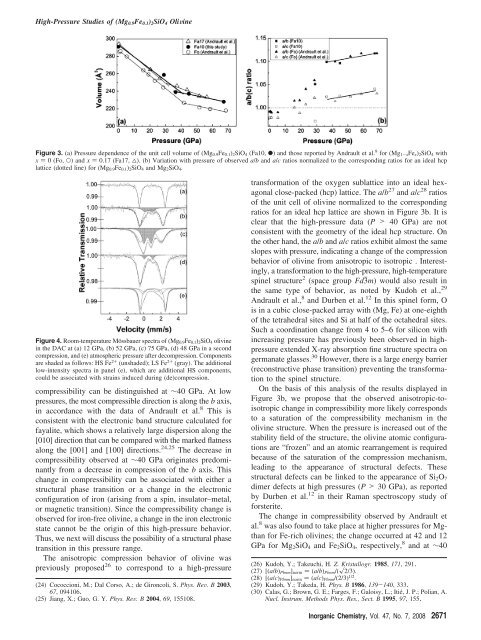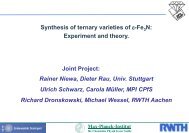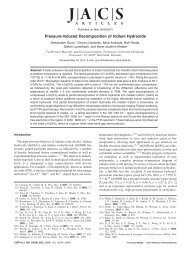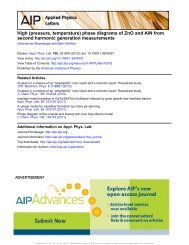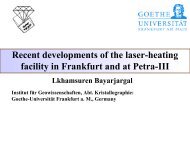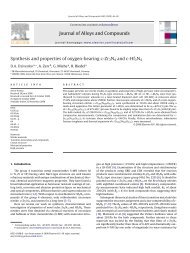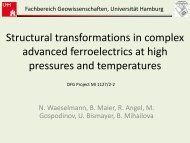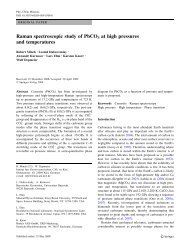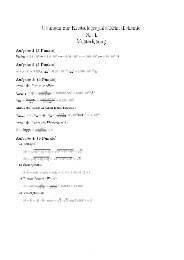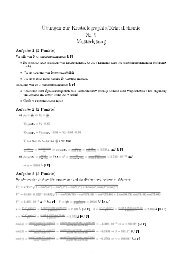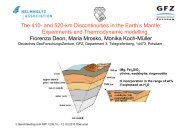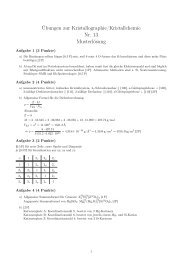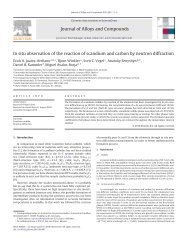High-Pressure Studies of (Mg0.9Fe0.1)2SiO4 Olivine Using Raman ...
High-Pressure Studies of (Mg0.9Fe0.1)2SiO4 Olivine Using Raman ...
High-Pressure Studies of (Mg0.9Fe0.1)2SiO4 Olivine Using Raman ...
You also want an ePaper? Increase the reach of your titles
YUMPU automatically turns print PDFs into web optimized ePapers that Google loves.
<strong>High</strong>-<strong>Pressure</strong> <strong>Studies</strong> <strong>of</strong> (<strong>Mg0.9Fe0.1</strong>)<strong>2SiO4</strong> OliWine<br />
Figure 3. (a) <strong>Pressure</strong> dependence <strong>of</strong> the unit cell volume <strong>of</strong> (<strong>Mg0.9Fe0.1</strong>)<strong>2SiO4</strong> (Fa10, b) and those reported by Andrault et al. 8 for (Mg1-xFex)<strong>2SiO4</strong> with<br />
x ) 0 (Fo, O) and x ) 0.17 (Fa17, 4). (b) Variation with pressure <strong>of</strong> observed a/b and a/c ratios normalized to the corresponding ratios for an ideal hcp<br />
lattice (dotted line) for (<strong>Mg0.9Fe0.1</strong>)<strong>2SiO4</strong> and Mg<strong>2SiO4</strong>.<br />
Figure 4. Room-temperature Mössbauer spectra <strong>of</strong> (<strong>Mg0.9Fe0.1</strong>)<strong>2SiO4</strong> olivine<br />
in the DAC at (a) 12 GPa, (b) 52 GPa, (c) 75 GPa, (d) 48 GPa in a second<br />
compression, and (e) atmospheric pressure after decompression. Components<br />
are shaded as follows: HS Fe 2+ (unshaded); LS Fe 2+ (gray). The additional<br />
low-intensity spectra in panel (e), which are additional HS components,<br />
could be associated with strains induced during (de)compression.<br />
compressibility can be distinguished at ∼40 GPa. At low<br />
pressures, the most compressible direction is along the b axis,<br />
in accordance with the data <strong>of</strong> Andrault et al. 8 This is<br />
consistent with the electronic band structure calculated for<br />
fayalite, which shows a relatively large dispersion along the<br />
[010] direction that can be compared with the marked flatness<br />
along the [001] and [100] directions. 24,25 The decrease in<br />
compressibility observed at ∼40 GPa originates predominantly<br />
from a decrease in compression <strong>of</strong> the b axis. This<br />
change in compressibility can be associated with either a<br />
structural phase transition or a change in the electronic<br />
configuration <strong>of</strong> iron (arising from a spin, insulator–metal,<br />
or magnetic transition). Since the compressibility change is<br />
observed for iron-free olivine, a change in the iron electronic<br />
state cannot be the origin <strong>of</strong> this high-pressure behavior.<br />
Thus, we next will discuss the possibility <strong>of</strong> a structural phase<br />
transition in this pressure range.<br />
The anisotropic compression behavior <strong>of</strong> olivine was<br />
previously proposed 26 to correspond to a high-pressure<br />
(24) Cococcioni, M.; Dal Corso, A.; de Gironcoli, S. Phys. ReV. B2003,<br />
67, 094106.<br />
(25) Jiang, X.; Guo, G. Y. Phys. ReV. B2004, 69, 155108.<br />
transformation <strong>of</strong> the oxygen sublattice into an ideal hexagonal<br />
close-packed (hcp) lattice. The a/b 27 and a/c 28 ratios<br />
<strong>of</strong> the unit cell <strong>of</strong> olivine normalized to the corresponding<br />
ratios for an ideal hcp lattice are shown in Figure 3b. It is<br />
clear that the high-pressure data (P > 40 GPa) are not<br />
consistent with the geometry <strong>of</strong> the ideal hcp structure. On<br />
the other hand, the a/b and a/c ratios exhibit almost the same<br />
slopes with pressure, indicating a change <strong>of</strong> the compression<br />
behavior <strong>of</strong> olivine from anisotropic to isotropic . Interestingly,<br />
a transformation to the high-pressure, high-temperature<br />
spinel structure 2 (space group Fdj3m) would also result in<br />
the same type <strong>of</strong> behavior, as noted by Kudoh et al., 29<br />
Andrault et al., 8 and Durben et al. 12 In this spinel form, O<br />
is in a cubic close-packed array with (Mg, Fe) at one-eighth<br />
<strong>of</strong> the tetrahedral sites and Si at half <strong>of</strong> the octahedral sites.<br />
Such a coordination change from 4 to 5–6 for silicon with<br />
increasing pressure has previously been observed in highpressure<br />
extended X-ray absorption fine structure spectra on<br />
germanate glasses. 30 However, there is a large energy barrier<br />
(reconstructive phase transition) preventing the transformation<br />
to the spinel structure.<br />
On the basis <strong>of</strong> this analysis <strong>of</strong> the results displayed in<br />
Figure 3b, we propose that the observed anisotropic-toisotropic<br />
change in compressibility more likely corresponds<br />
to a saturation <strong>of</strong> the compressibility mechanism in the<br />
olivine structure. When the pressure is increased out <strong>of</strong> the<br />
stability field <strong>of</strong> the structure, the olivine atomic configurations<br />
are “frozen” and an atomic rearrangement is required<br />
because <strong>of</strong> the saturation <strong>of</strong> the compression mechanism,<br />
leading to the appearance <strong>of</strong> structural defects. These<br />
structural defects can be linked to the appearance <strong>of</strong> Si2O7<br />
dimer defects at high pressures (P > 30 GPa), as reported<br />
by Durben et al. 12 in their <strong>Raman</strong> spectroscopy study <strong>of</strong><br />
forsterite.<br />
The change in compressibility observed by Andrault et<br />
al. 8 was also found to take place at higher pressures for Mgthan<br />
for Fe-rich olivines; the change occurred at 42 and 12<br />
GPa for Mg<strong>2SiO4</strong> and Fe<strong>2SiO4</strong>, respectively, 8 and at ∼40<br />
(26) Kudoh, Y.; Takeuchi, H. Z. Kristallogr. 1985, 171, 291.<br />
(27) [(a/b)Pbnm]norm ) (a/b)Pbnm/(2/3).<br />
(28) [(a/c)Pbnm]norm ) (a/c)Pbnm/(2/3) 1/2 .<br />
(29) Kudoh, Y.; Takeda, H. Phys. B 1986, 139-140, 333.<br />
(30) Calas, G.; Brown, G. E.; Farges, F.; Galoisy, L.; Itié, J. P.; Polian, A.<br />
Nucl. Instrum. Methods Phys. Res., Sect. B 1995, 97, 155.<br />
Inorganic Chemistry, Vol. 47, No. 7, 2008 2671


